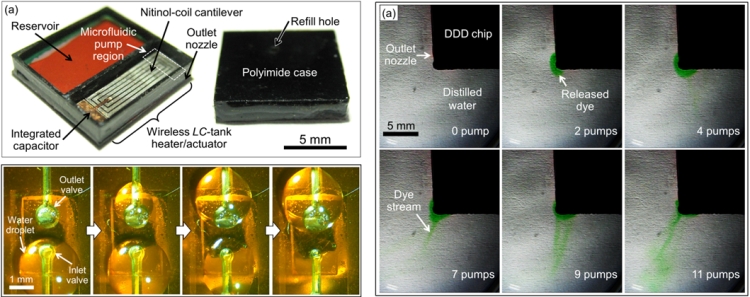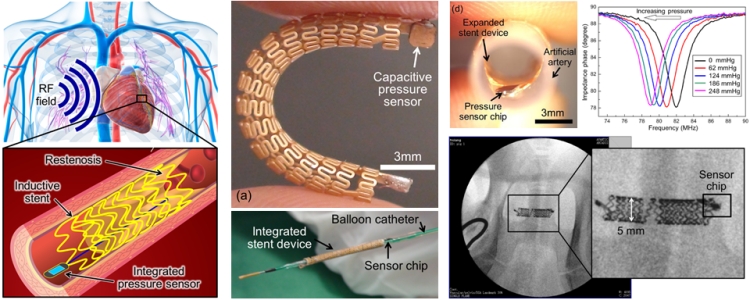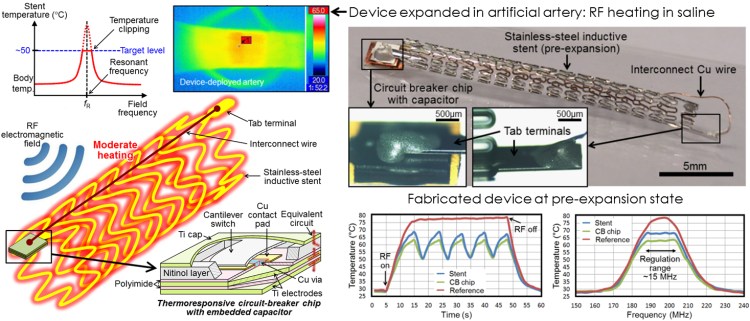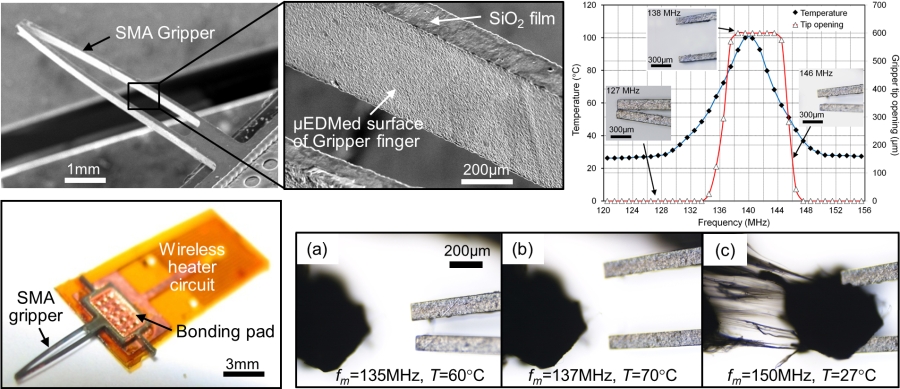 Research
ResearchRapid advances in medical technologies are revolutionizing the way we fight disease. Microsystems with embedded sensors and actuators have an enormous potential to play a key role in minimally invasive diagnosis and therapy that are increasingly playing a critical role in medicine. Highly miniaturized "smart" implantables and surgical tools are the key devices in this area. We explore how MEMS and micro/nanofabrication technologies can contribute to realizing such devices and innovating medical technologies.
MEMS technology is enabling pinpoint drug delivery to localized disease that is expected to maximize the efficacy of chemotherapy while drastically reducing its side effects compared with the case of systemic administration. We are developing implantable wireless drug delivery devices (DDD) packaged in a form of miniaturized chip. The device shown below was developed to have a drug reservoir in it, and controlled drug release from the reservoir was achieved with the photo-defined microvalve structures of PNIPAM hydrogel by thermally actuating them via wireless power transfer using external RF fields (refer to Micromachined Actuators), which opened/closed the micro nozzles created in the reservior wall through which the drug could diffuse out.

Another DDD chip that has embedded a microfluidic pump has been developed to achieve forced and faster drug ejection with higher temporal release controllability. The chip was integrated with the Nitinol micro-coil actuator (refer to Micromachined Actuators) to drive the micro pump wirelessly, coupled with micromachined check valves to produce regulated drug flow in the device.

Stents are tubular mechanical devices implanted into arteries to scaffold the channels narrowed by plaque deposition. Stents are playing vital roles in the treatment of both vascular and non-vascular diseases, with its main application being cardiovascular disease for stenosis management. However, stenting often causes restenosis, i.e., re-narrowing of the vessel. We are developing a new class of stent devices, "smart" stents, that are integrated with MEMS transducers to realize advanced diagnosis and treatment of restenosis via implanted stents. These devices are based on custom-designed alloy-based stents that function as RF antennae to enable wireless operation of the devices. One type of them was integrated with micromachined capacitive pressure sensors based on medical-grade stainless steel (refer to Micromachined Sensors) for wireless detection of local blood pressure shifting caused by re-narrowing. The fabricated devices were tested with pig models to demonstrate its targeted functionality.

We are also investigating another type of smart stent, active stent, RF powered to perform moderate heating of the implanted site toward realizing endohyperthermia treatment of restenosis. A stent-based resonant circuit serves as a frequency-selective wireless heater, applying local thermal stress to the vessel tissue to suppress in-stent restenosis. The biocompatible MEMS circuit breaker chip (refer to Micromachined Sensors) is integrated with the stent to prevent it from overheating, enabling safeguarded wireless operation of hyperthermia treatment via the implant. This work has demonstrated wireless heating and temperature regulation using fabricated prototypes, which will be further optimized toward their in-vivo studies.

We have demonstrated the first micro rotary motor enabled with a novel ferrofluid-based levitation mechanism, with a specific application focus on advanced microendoscopes that enable circumferential scanning of probing beam. The ferrofluid in the micro motor serves as an extremely simple, miniaturized bearing that sustains on the magnet rotor and levitate it inside a tubular substrate, an endoscope catheter (ferrofluid micro bearing - refer to Micromachined Actuators). The rotor is electromagnetically driven by micropatterned stator coils formed around the outer walls of the catheter, enabling 90°-step angular actuation of the rotor. The fabricated prototypes were successfully operated for continuous rotation of the prism mirrors coupled with the rotors. The results indicate a promising potential of the device for 3-D viewing microendoscopy with different modalities including ultrasound and optical coherence tomography.

Miniaturized grippers with high gripping force, high robustness, and biocompatibility are a key component that will advance microsurgical tools and techniques. For such devices, eliminating mechanical interface and electrical wiring can significantly simplifies the device archetecture, which in turn minimizes the space occupied by them and eases surgical procedures. Future surgery is looking at the use of swallowable microsurgical robots, in which wireless control of micro tools for gripping, cutting, burning, etc. is an essential requirement. Toward these applications, we have developed a micro gripper based on Nitinol, a biocompatible shape-memory alloy, that can be radio controlled via RF power transfer to the wireless heater circuit on which the Nitinol gripper structure is integrated for its thermal actuation.

Jump to other research theme:
The main page of Research

